This document has been consolidated into IMSBC Code
1 Test procedures for materials
which may liquefy and associated apparatus
192 In the beginning of the first sentence, replace the term "Three" with
"Five". After the sentence "As each method has its advantages, the selection of the
test method should be determined by local practices or by the appropriate
authorities", add two new sub-paragraphs as follows:
193 Add a new paragraph 1.5 as follows:
"1.5 Modified Proctor/Fagerberg test procedure for Coal
1.5.1 Scope
This procedure details the laboratory determination of Transportable
Moisture Limit (TML) for coals up to a nominal top size of 50 mm. The procedure is
based on a modification of the Proctor/Fagerberg test described in section 1.3 of
this appendix.
Key modifications to the original test procedure contained in section
1.3 of this appendix are:
-
.1 Sample preparation to facilitate the testing of 0 x 50 mm coal through
reconstitution to -25 mm;
-
.2 Use of a 150 mm diameter compaction cylinder; and
-
.3 Sample compaction using a hammer equivalent to the Proctor/Fagerberg
"D" energy hammer.
The Transportable Moisture Limit is the moisture content corresponding to
the intersection of the 70% degree saturation curve and the test sample compaction
curve.
In the case of coals where moisture freely drains from the sample such
that the test sample compaction curve does not extend to or beyond 70% saturation,
the test is taken to indicate a cargo where water passes through the spaces between
particles and there is no increase in pore water pressure. Therefore, the cargo is
not liable to liquefy. (See subsection 7.2.2 of this Code).
The procedure commences with a drum of coal containing a sample of not
less than 170 kg delivered to the testing laboratory and terminates with the
laboratory reporting the test result for the coal. Details of the sample collection
process are excluded from this procedure. However it is important that the sample
accurately represents the size distribution of the cargo and reference should be
made to the normative reference list below.
1.5.2 Normative references
The following documents are referenced in this procedure. For dated
references, only the cited edition applies. For undated references, the latest
edition of the referenced document (including any amendments) applies.
-
– AS 1289.3.5.1:2006, Methods of testing soils for engineering purposes.
Method 3.5.1: Soil classification tests – Determination of the soil
particle density of a soil – Standard method;
-
– ISO 589:2008, Hard Coal – Determination of total moisture;
-
– ISO 3319-2:2013, Test requirements and testing – Part 2: Test sieves of
perforated metal plate; and
-
– ISO 13909-4:2001, Hard coal and coke – Mechanical sampling – Part 4 –
Coal – Preparation of test samples.
1.5.3 Definitions
(1) Transportable Moisture Limit (TML)
The Transportable Moisture Limit (TML) of a cargo which may liquefy
means the maximum moisture content of the cargo which is considered safe for
carriage in a ship not complying with the requirements in subsection 7.3.2 of this
Code.
(2) Test outcomes
The Transportable Moisture Limit determined by this procedure is the
moisture content corresponding to the intersection of the 70% degree saturation
curve and the test sample compaction curve. This is also referred to as the PFD70
value (Proctor/Fagerberg – D energy hammer – 70% saturation).
Where moisture freely drains from the sample or the cylindrical mould at
moisture content such that the test sample compaction curve does not extend to or
beyond 70% saturation (as described in paragraph 1.5.5.3(4)), the test is taken to
indicate a cargo where water passes through the spaces between particles and there
is no increase in pore water pressure. Therefore, the cargo is not liable to
liquefy. (See subsection 7.2.2 of this Code).
(3) Optimum Moisture Content (OMC)
The Optimum Moisture Content is the moisture content corresponding to
the maximum compaction (maximum dry density) under the specified compaction
condition.
(4) Gross water content or total moisture (W1)
The moisture content of a sample is calculated as the mass of water
divided by the total mass of solids plus water and is referred to as either the
gross water content or the total moisture content. Gross water content is to be
determined using the method for determining total moisture defined in the standard
ISO 589:2008.
1.5.4 Determination of the TML of blends of two or more coals
In circumstances where a shipper intends to load a cargo consisting of a
blend of two or more coals, the shipper may:
1.5.5 Modified Proctor/Fagerberg test procedure for coal
1.5.5.1 Apparatus
(1) Work area
The work area should be located where the samples are protected from
excessive temperatures, air currents and humidity variations. All samples should be
stored in suitable sample containers, including plastic sample bags, and the
containers should be sealed.
(2) Standard sieves
Square aperture laboratory sieves of 16 mm and 25 mm aperture as
nominated in ISO 3319-2:2013 are required for reconstitution of the sample at 25 mm
top size. A 2.36 mm sieve is required for generation of + 2.36 mm and –2.36 mm
fractions for particle density determination. Optionally a 2 mm sieve may be used
for this purpose.
(3) Proctor/Fagerberg apparatus
The Proctor/Fagerberg apparatus consists of a cylindrical stainless steel
mould having 150 mm diameter and 120 mm height with a removable extension piece (the
compaction cylinder) and a compaction tool guided by a pipe at its lower end (the
compaction hammer), which are shown in figure 1.5.1. A schematic diagram of the
Proctor/Fagerberg apparatus is shown in figure 1.5.2 with dimensions and tolerances
indicated in table 1.5.5.

Figure 1.5.1 Example of
Proctor/Fagerberg test apparatus, hammer and hammer guide
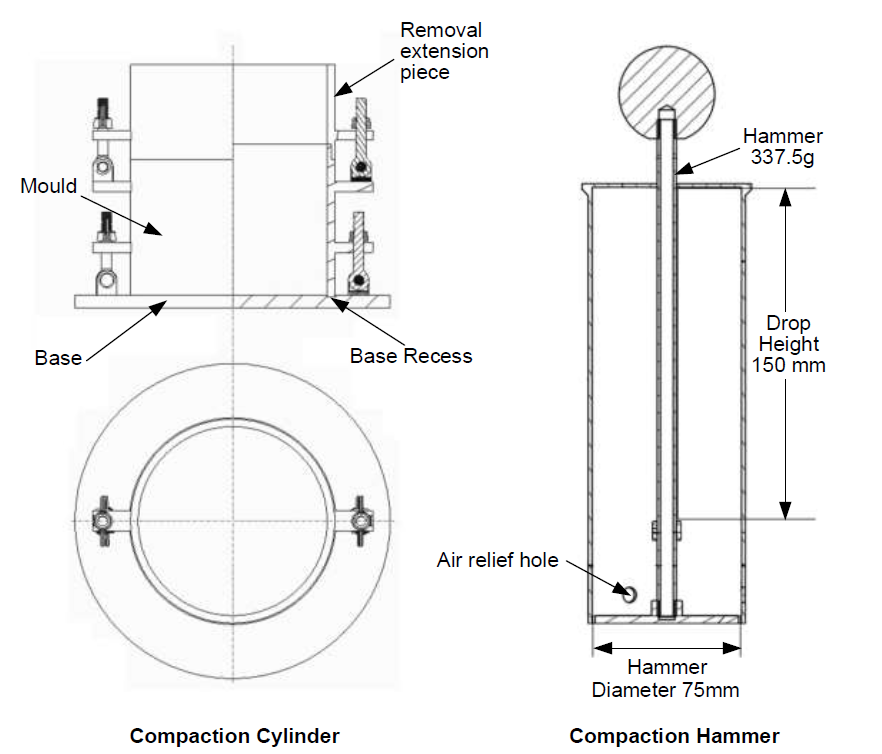
Figure 1.5.2 Schematic of a
Proctor/Fagerberg apparatus
(4) Compaction hammer
A "D" energy equivalent compaction hammer is used for this test.
Dimensions are shown in figure 1.5.2 and table 1.5.5. (Note: the compaction hammer
has been modified to match the mould used.)
(5) Drying oven
The drying oven should be ventilated, with forced circulation of air or
inert gas, typically with a stainless steel interior and capable of maintaining a
temperature within the range of 105°C ± 5°C.
(6) Weighing balance
The weighing balance should be capable of weighing the sample and the
container, as received, with an accuracy of better than ± 5 g.
(7) Pycnometer
Water pycnometry equipment is used to determine the density of the full
sized coal (non-crushed) in accordance with AS 1289.3.5.1:2006. Specific equipment
required is as follows:
- – a conical flask or density bottle of 250 ml capacity;
- – a vacuum desiccator or other vacuum equipment;
- – a drying oven set to 105°C to 110°C;
- – balances – one with ± 0.05 g accuracy and the second
with ± 1 g accuracy;
- – a 0°C to 100°C thermometer;
- – a 2.36 mm sieve (as noted in paragraph 1.5.5.1(2))
- – a vacuum source;
- – a water bath set at 60°C;
- – distilled, demineralized or deionized water;
- – a wash bottle containing water;
- – a wire basket to hold the + 2.36 mm sample;
- – a container filled with water to hold the wire basket
without interference; and
- – a scale to weigh the basket both suspended in water
and drained.
(8) Containers for hand mixing and sample preparation
Sufficient heavy-duty plastic buckets with lids of not less than 10
litres capacity are required for storage and handling. Heavy-duty plastic bags (200
micron thick or greater) are required for storage and hand mixing of samples.
(9) Flat scraping device
A thin steel scraper is required for separating the remnant sample
formed in the extension piece lying above the top level of the mould. For ease of
use, the scraper should have dimensions of 160 mm wide, 200 mm long and 3 mm to 5 mm
thick, such as that shown in figure 1.5.3.

Figure 1.5.3 Typical scraping
device
(10) Drying trays
Drying trays or pans should have a smooth surface, be free from
contamination and heat resistant, for example stainless steel or enamel. Dimensions
should be suitable to fit in the drying oven and ensure that the total sample can be
contained at a loading of about 1 g/cm2 of surface area.
(11) Spray bottle
A suitable plastic bottle is required to add a mist spray of water to the
sample.
(12) Gloves
Heat resistant gloves are required for removal of hot trays and dishes.
(13) Sample divider
A suitable sample divider as specified in ISO 13909-4:2001 is required
for sub-sampling the primary sample and blending the reconstituted sample for
testing.
1.5.5.2 Sampling and sample preparation
(1) General
This procedure commences with receipt of sample of not less than 170 kg,
sealed in a heavy duty (200 micron thick) plastic bag and contained in a suitable
drum (e.g. 220 litres). This packaging ensures the sample does not dry prior to TML
determination.
(2) Sample preparation
Representative samples are required that have been obtained using ISO
13909-4:2001 and if required may be partially air dried or partially dried at a
temperature of 40°C or less to reduce the water content to a starting point suitable
for dry sieving the coal with minimal fines adhering to the oversize fraction. For
this purpose, samples should not be dried below 6% total moisture. The
representative subsamples for the test should not be fully dried, except in the case
of gross water content determination.
(2.1) Sample homogenization and division
Take the as-received sample and divide into individual sub-samples using
a sample dividing apparatus as specified in ISO 13909-4:2001. Place these subsamples
into heavy-duty plastic bags.
(2.2) Reconstituted sample preparation procedure
When the sample contains particles above 25 mm, the reconstitution
process below should be applied.
In this process, particles above 25 mm are removed from the sample and
replaced by an equivalent mass of particles in the range 16 mm to 25 mm. Through
this process a final reconstituted sample of sufficient mass for TML testing is
generated which contains a maximum particle size of 25 mm.
One of two methods may be selected to generate the reconstituted sample:
.
Method 1 Splitting the full as received sample and
reconstitution
(i) Take the full as-received sample;
(ii) Screen at 25 mm, 16 mm and 2.36 mm. If a 2.36 mm screen is not
available, a 2 mm screen may be used;
(iii) Weigh each of the four size fractions and calculate the percentage
represented by each size fraction;
(iv) Sub-divide from each size fraction below 25 mm the required mass to
create a 25 kg reconstituted sample using the sample size components specified in
table 1.5.1:
Table 1.5.1 Reconstitution
size proportions (Method 1)
| Size fraction
|
Quantity
|
| -2.36 mm (or -2 mm)
|
percentage of this fraction in the original
sample
|
| 2.36 mm (or 2 mm) to 16 mm
|
percentage of this fraction
|
| 16 mm to 25 mm
|
percentage of this fraction plus the percentage of
+ 25 mm coal
|
(v) Combine each size fraction;
(vi) Fully mix the reconstituted sample;
(vii) Split the sample into approximately eight representative
sub-samples and place each into a heavy duty plastic bag. These bags now contain the
sample for Proctor/Fagerberg testing.
(viii) A sample of particles passing a 2.36 mm screen (or 2.0 mm if 2.36
mm is not available) is required for particle density pycnometry.
Method 2 Scalping particles above 25 mm and replacement with 16 mm to
25 mm particles
This method is described in figure 1.5.4 and table 1.5.2. The
reconstitution process commences where the coal is initially sieved into particle
sizes larger than 25 mm and smaller than 25 mm. Coal particles in the size range of
16 mm to 25 mm are extracted from separate subsamples and reconstituted back into
the original -25 mm screened coal based on a mass equivalent to the + 25 mm sized
coal removed from the initial sample to provide a final reconstituted sample of
sufficient mass for TML testing.
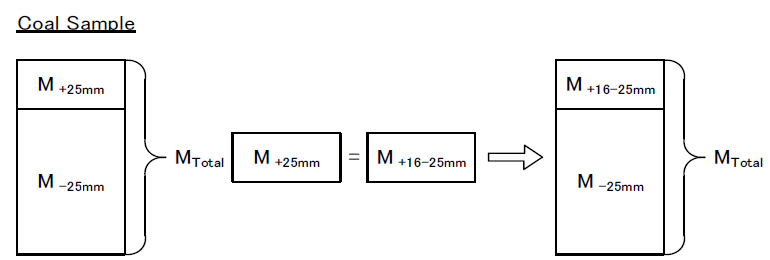
Figure 1.5.4 Overview of
sample reconstitution (Method 2)
Table 1.5.2 Sample
reconstitution (Method 2)
| Step
|
Example
|
| a)
Generate a sample of approximately 25 kg which is sufficient to
complete approximately eight Proctor/Fagerberg tests.
|
Assumes each subsample bag contains 8 kg to 10 kg.
|
| b)
Screen this sample at 25 mm, ensuring minimal adhering fines on the
+25 mm fraction. Weigh the +25 mm coal.
|
For
a coal containing 20% +25 mm material, approximately 5 kg of initial
sample is removed.
|
| c)
Create sufficient 16 mm to 25 mm coal by screening one or more
further subsample bags of coal at 16 mm and 25 mm.
|
In
the above example, 5 kg of 16 mm to 25 mm coal is required.
|
| d)
Extract an amount of 16 mm to 25 mm coal of mass equal to the mass
of +25 mm removed in step b) within ± 0.05 kg using a rotary sample
divider or similar device, recombining sector trays as required to
obtain the required mass.
|
5 kg
in the above case.
|
| e)
Add the mass of 16 mm to 25 mm coal from step d) to the -25 mm coal
from step b). Blend and divide into approximately eight test
portions using a rotary sample divider or similar device.
|
|
f)
Place each reconstituted test portion in heavy duty plastic bags,
label and seal.
These now become the test portions used for
Proctor/Fagerberg testing.
|
Each
bag should contain approximately 2.5 kg to 3 kg of reconstituted -25
mm coal.
|
| g)
Discard the +25 mm and -16 mm coal.
|
|
(3) Initial moisture
Initial moisture is to be determined on a test portion from table 1.5.2
step e) using the method provided in ISO 589:2008. This moisture value provides a
guide to the moisture steps required to develop the Proctor/Fagerberg compaction
curve.
(4) Particle density measurement
In accordance with water pycnometer standard AS 1289.3.5.1:2006, measure
the density of solids on the full size range (non-crushed) coal. The density of
solids is used for determining the void ratio for plotting compaction curves. The
recommended methodology is described below:
-
(a) Generate a full particle size sample of approximately 10 kg, weigh
and then screen the entire contents at 2.36 mm. If a 2.36 mm screen is
not available, a 2 mm screen may be substituted. Record the following:
-
(i) The total mass of the material;
-
(ii) The mass of +2.36 mm material; and
-
(iii) The mass of -2.36 mm material.
-
(b) Calculate the percentage of -2.36 mm coal in the sample.
-
(c) Divide the +2.36 mm coal into two test portions using sample dividing
apparatus as specified in ISO 13909-4:2001 such as a rotary sample
divider. Place each test portion in a heavy duty plastic bag and label.
-
(d) Divide the -2.36 mm coal into two test portions, place each test
portion in a heavy duty plastic bag and label.
-
(e) Determine the density of solids of the +2.36 mm fraction following
the method described in Section 5.2 of AS 1289.3.5.1:2006. As noted in
the standard, duplicate determinations are required.
-
(f) Determine the density of solids of the -2.36 mm fraction using the
method described in Section 5.1 of the above standard with the following
clarifications:
-
(i) Use of 250 mm conical or pycnometry flasks is
recommended.
-
(ii) From the sample bag pour 1 litre of coal into a beaker
of known tare weight.
-
(iii) Weigh the 1 litre sample and calculate the approximate
bulk density of the material.
-
(iv) Remove a portion of the sample (nominally a mass in
kilograms of 0.18 x bulk density) and place into the flask,
and complete the pycnometry analysis.
-
(v) A water bath temperature of 60°C is recommended.
-
(g) Calculate the density of solids using the method in Section 6 of AS
1289.3.5.1:2006.
1.5.5.3 Test procedure
(1) Variables and definitions
The variables and definitions used in the determination of TML are
summarized in table 1.5.3 with some key variables as illustrated in figure
1.5.5.
Table 1.5.3 Summary of
variables and definitions
| Variable
|
Unit
|
Symbol / value used in calculations
|
| Mass of empty cylinder and base
|
g
|
A
|
| Mass of cylinder, base and tamped test portion
|
g
|
B
|
| Wet mass of test portion in the mould
|
g
|
C = B − A
|
| Wet mass of test portion removed from the mould
|
g
|
C1
|
| Dry mass of test portion removed from the mould
|
g
|
D1
|
| Gross water content
|
%
|
W1
|
| Dry mass of test portion in the mould
|
g
|
D
|
| Mass of water in the mould
|
g
|
E
|
| Volume of cylinder
|
cm3
|
V
|
| Density of solids
|
g/cm3
|
d
|
| Density of water
|
g/cm3
|
ρw
|
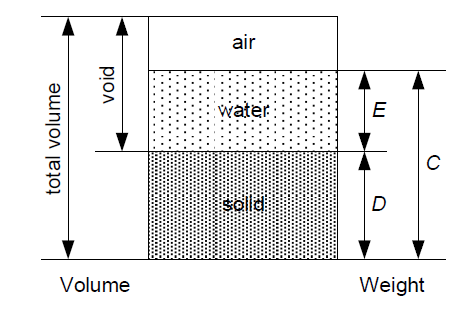
Figure 1.5.5 Illustration of
key variables
(2) Establishment of the initial compaction point
The initial compaction point is obtained using the first test portion of
the reconstituted material at the initial moisture content. For each compaction
point determination, all steps in the procedure from packing the mould to weighing
the mould and sample are to be completed at the same time without breaks. In any
case, coal should not be left in the mould for longer than thirty minutes prior to
weighing.
The test procedure is as follows:
-
| (a) Clean the
mould, collar and base plate. Inspect and clean the
hammer and ensure that it moves freely in the guide
tube.
|
| (b) Determine
the mass, A, of the empty cylinder, comprising
the mould plus base plate.
|
| (c) Assemble
the mould, collar and base plate and place the assembly
on a stable bench.
|
| (d) Place
approximately 0.5 litre (one fifth of the full 2.5
litres) of the test portion into the mould, level, and
then tamp uniformly over the surface by dropping the
hammer 25 times vertically through the full height of
the guide pipe, moving the guide pipe to a new position
after each drop. The required pattern for even
compaction of each layer in the mould is shown in figure
1.5.6.
|
| (e) Repeat
step (d) four more times so that there are 5 layers of
material in the mould. Ensure that the compacted test
portion with the final layer is above the top of the
compaction mould whilst the extension piece is still
attached.
|
| (f) When the
last layer has been tamped, remove the extension piece
taking care not to disturb the compacted test portion
inside. Level the compacted test portion to the top of
the mould using the flat scraping device, ensuring that
any large particles that may hinder levelling of the
test portion are removed and replaced with material
contained in the extension piece and re-level. If any
holes in the surface are still observed after levelling,
they should be manually filled with finer material
contained in the extension piece. Care should be taken
to avoid any further compaction of the test
portion.
|
| (g) Determine
the mass, B, of the mould and compacted coal and
then calculate the mass, C, of the wet test
portion using the equation:
|
|
|

|
(1)
|
|
| (h) When the
weight of the cylinder with the tamped test portion has
been determined, remove the test portion from the mould,
determine the mass of the wet test portion,
C1, and dry the entire test portion in an
oven at 105°C until constant mass is achieved. After
drying, determine the weight, D1, of the
dried test portion and then calculate the percentage
gross water content, W1, as follows:
|
|
|

|
(2)
|
|
| (i) Using the
calculated gross water content, calculate the mass of
the dry test portion in the mould, D, using the
equation:
|
|
|

|
(3)
|
|
| (j) Calculate
the mass, E, of water in the mould using the
equation:
|
|
|

|
(4)
|
|
(k) Discard
the used coal sample. Coal from a previously compacted
test portion should not be reused.
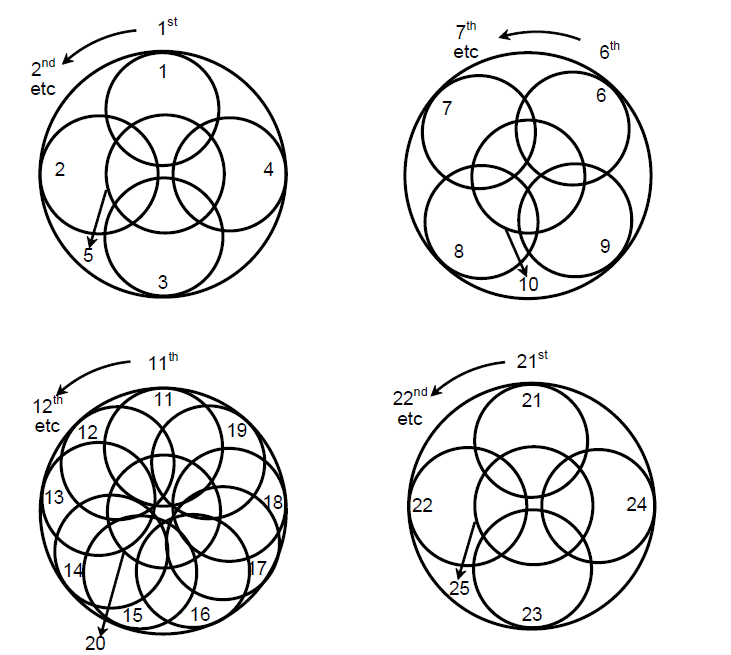
Figure 1.5.6 Recommended compaction
patterns
|
(3) Establishment of complete compaction curve
The range of water contents should be adjusted so that partially dry to
almost saturated test portions are obtained. Care should be taken to follow the
precaution in paragraph 1.5.5.3(2) above regarding prompt completion of each point
in the compaction curve.
The test procedure is as follows:
-
(a) For each compaction test, a predetermined amount of water is added to
the test portion (approximately 2.5 kg) in a heavy duty plastic bag. The
water quantity added is that required to increase the moisture content
to the target value for the next test. The water should be added as a
mist spray to the surface of the individual test portions. The water at
this point should be added slowly and in small quantities, as the
introduction of large amounts of water may induce localized compaction
behaviour.
-
(b) After the calculated water addition, the test portion should then be
mixed thoroughly in the plastic bag by sealing the bag and turning it
over repeatedly for 5 minutes.
-
(c) The test portion should then be allowed to equilibrate for a minimum
of 12 hours prior to compaction testing.
-
(d) Repeat steps (a) to (k) from paragraph 1.5.5.3(2).
-
(e) Repeat the test between four and seven times using the other prepared
test portions with different water contents to obtain at least five
points on the compaction curve. The water contents should be chosen so
that:
-
.1 at least one point corresponds to moisture content higher
than the Optimum Moisture Content (OMC) or than the value
corresponding to 70% of degree of saturation (S), in order
to satisfactorily define the compaction curve; and
-
.2 at least one point corresponds to the degree of saturation
(S) between 70% and 80%, in order to effectively assess the
PFD70 value.
A point close to a degree of saturation (S) of 80% will also
assist accurate assessment if the OMC is greater than 70%.
(4) Visual appearance of coal in the cylindrical mould
In order for the test to obtain a PFD70 value, all tests conducted at or
below the PFD70 moisture value should have an even moisture distribution throughout
the cylindrical mould.
Two examples of tests using samples of the same coal at different
moisture contents are shown in figure 1.5.7. The left hand photograph shows a coal
specimen at a relatively low degree of saturation. Note that the coal remains in
place following removal of the collar. The right hand photograph shows a specimen
near or possibly above 70% degree of saturation. Once again the coal remains in
place following removal of the collar. Both tests provided valid points on the
compaction curve.

Figure 1.5.7 Photographs
showing valid tests for a partially saturated test portion (left) and a near
fully saturated test portion (right)
Coals where water passes through the spaces between particles exhibit
moisture migration within the Proctor/Fagerberg cylindrical mould. Moisture
migration may take place when the degree of saturation of the specimen is less than
70%.
Evidence of moisture migration is from visual observation at the
completion of each test as follows:
-
.1 Moisture leakage from the base of the mould is evident as
shown in figure 1.5.8; and
-
.2 The portion above the top of the cylindrical mould appears unsaturated
and the test portion maintains its structure without deformation or
movement.
In this case, moisture migration has occurred and hence for this coal
water passes through the spaces between particles.
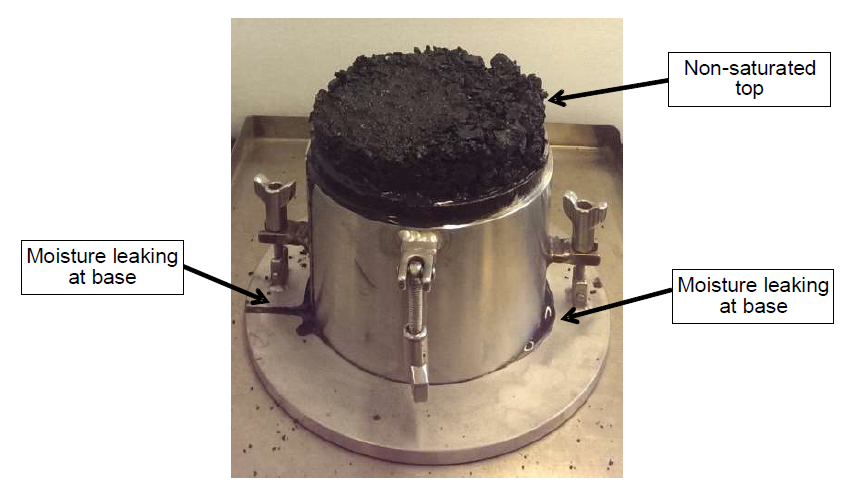
Figure 1.5.8 Test showing
water leakage from the base of the cylindrical mould indicating moisture
migration
(5) Calculation of key parameters for determination of compaction
curve
Carry out the following calculations for each compaction test:
|
d |
= |
density of solids, g/cm3 (t/m3) by
pycnometry (see 1.5.5.2(4)). |
|
γ |
= |
dry bulk density, g/cm3 (t/m3) |
| = |
D/V |
|
ev |
= |
net water content (percentage by volume) |
| = |
(E/D) × 100 × d/ρw
where
ρw= density of water, g/cm3
(t/m3)
|
|
e |
= |
void ratio (volume of voids divided by volume of
solids) |
| = |
(d/γ) -1 |
|
S |
= |
degree of saturation (percentage by volume) |
| = |
ev /e |
|
W1 |
= |
gross (total) water content (percentage by mass) (see
1.5.5.3(2)(h)). |
(6) Presentation of compaction results
Record all the compaction test results in a suitable spreadsheet (such as
that shown in table 1.5.4) and from this spreadsheet create a compaction curve as
shown in figure 1.5.9 by plotting the calculated void ratio (e) for each
compaction test on the ordinate against either the net or gross water content
plotted on the abscissa.
The lines in figure 1.5.9 correspond to plots of void ratio (e)
versus net water content (ev) at 20%, 40%, 60%, 70%, 80% and 100%
degree of saturation (S). These lines are calculated at five values of void
ratio using the formulae in section 1.5.5.3(7). (Note: These lines corresponding to
degree of saturation will be curved in the case of plotting gross water content on
the abscissa.)
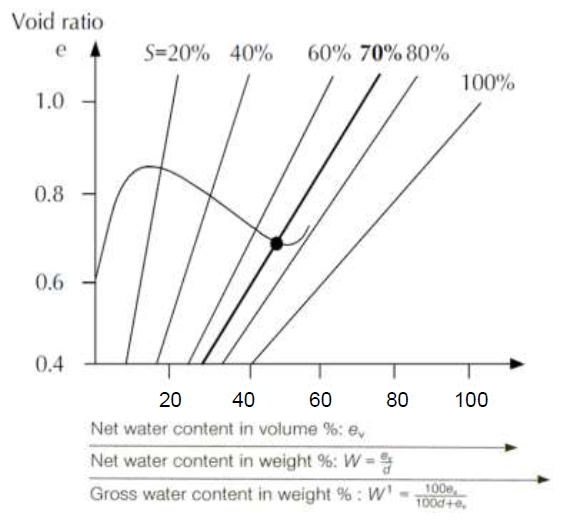
Figure 1.5.9 Typical
compaction curve
(7) Sample compaction curve
An example of the results obtained when applying the Modified
Proctor/Fagerberg test to a coal sample is provided in table 1.5.4, with the
corresponding compaction curve and the 70% degree of saturation line plotted as
described below.
The preferred approach to presenting the results is to plot the void
ratio (
e) against the gross water content (
W1) allowing
moisture for any saturation level to be read directly from the plot as gross water
content. This approach is shown in figure 1.5.10. The saturation lines are plotted
according to the equation:
The intercept of the compaction curve with the 70% degree of saturation
line in figure 1.5.10 occurs at a gross water content of 15.4%, which is the
Transportable Moisture Limit (TML). For this example, the Optimum Moisture Content
(OMC) occurs at a degree of saturation of about 85%.
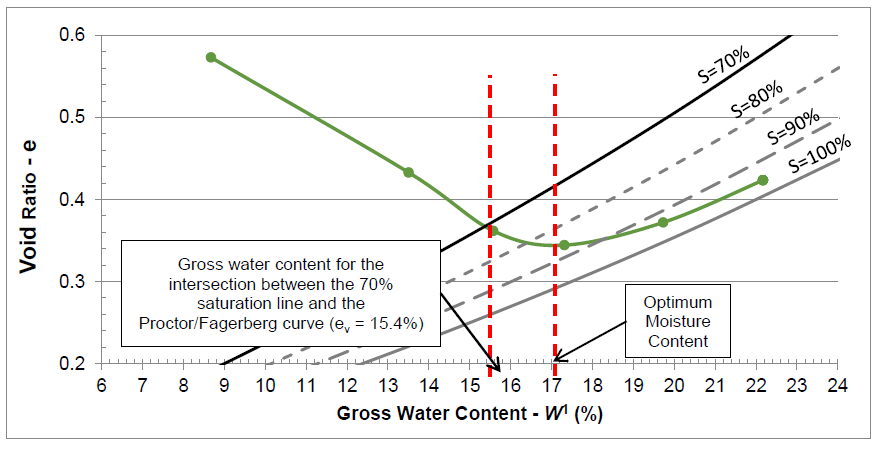
Figure 1.5.10 Example of a
measured compaction curve for void ratio versus gross water content with the
70%, 80%, 90% and 100% degree of saturation lines plotted
(8) Determination of transportable moisture limit
(8.1) Determination of PFD70 moisture content
The PFD70 value is determined as the gross (total) water content
corresponding to the intersection of the compaction curve and the line S = 70%
saturation. The Optimum Moisture Content (OMC) is the gross (total) moisture content
corresponding to the maximum compaction (maximum dry density and minimum void ratio)
under the specified compaction condition.
The test procedure is applicable for determination of coal TML where the
degree of saturation corresponding to the OMC of the coal is at or greater than 70%.
Where the OMC lies below 70% degree of saturation, this test is not applicable for
the specific coal and the PFD70 may overstate the TML. In such cases, the
certificate of analysis should state that the OMC is below 70% saturation and the
shipper should consult with an appropriate authority.
(8.2) Cases where the highest determinable point on the compaction
curve lies below 70% saturation
In coals where there is visual evidence that water passes through the
spaces between particles and the compaction curve does not extend to or beyond the
70% degree of saturation line, the coal is deemed to be free-draining and a TML
value is not applicable. By reference to section 7.2.2 of this Code, such coals are
cargoes which are not liable to liquefy, and hence are classified as Group B only.
1.5.6 Test report
The test report from application of the Modified Proctor/Fagerberg test
procedure should include the following information:
-
(a) Identification of the sample;
-
(b) A unique reference to this test procedure;
-
(c) Reference to the appropriate standard adopted for determining the
density of the solids:
-
(d) Either:
-
(i) The Transportable Moisture Limit (TML) of the sample,
expressed as the gross water content as a percentage of the
sample by mass;
-
(ii) The OMC lies below 70% degree of saturation and this
test procedure is not applicable; or
-
(iii) A statement that the test indicated that water passes
through the spaces between particles at moisture content
below the value corresponding to 70% degree of saturation,
and the coal is therefore Group B only.
-
(e) The solids density d in g/cm3.
Table 1.5.4 Example of TML determination for a coal sample using the
Modified Proctor/Fagerberg test procedure for coal
| Date
|
|
|
|
Diameter of cylinder
|
|
150 mm
|
| Product
|
|
|
|
Height of cylinder
|
|
120 mm
|
| Sample
|
|
|
|
Volume of cylinder
|
|
2121 ml
|
| Initial
gross water content (%)
|
|
5.6
|
|
TML
|
|
15.4%
|
| Density of
solids
|
|
1416
kg/m3
|
|
|
|
|
| Laboratory
temperature
|
|
25°C
|
|
Size fraction
|
|
|
| Mass of
mould (A)
|
|
7271
g
|
|
Operator
|
|
|
| Initial
Dry density
|
|
899
kg/m3
|
|
Tamper
|
|
337.5 g
|

Table 1.5.5 Specifications and tolerances for Proctor/Fagerberg cylindrical
mould and hammer
| Parameter
|
Units
|
Dimension
|
Tolerance
|
| Hammer
mass
|
g
|
337.5
|
± 2
|
| Hammer
diameter
|
mm
|
75
|
±
0.2
|
| Drop
height
|
mm
|
150
|
± 2
|
| Tube
ID
|
mm
|
78
|
±
0.2
|
| Tube
OD
|
mm
|
82
|
±
0.2
|
| Tube wall
thickness
|
mm
|
2
|
±
0.2
|
| Tube
clearance
|
mm
|
1.5
|
±
0.2
|
| Mould inner
diameter
|
mm
|
150
|
±
0.5
|
| Mould inner
height
|
mm
|
120
|
± 1
|
| Mould inner
volume
|
cm3
|
2121
|
± 18
|
| Removable
extension piece height
|
mm
|
75
|
± 1
|
| Depth of
recess into base to seat
|
mm
|
1
|
±
0.2
|
| Gap between
mould and base
|
mm
|
≤
0.1
|
|
| Gap between
mould and extension piece
|
mm
|
|
(0 to +
0.1)
|
| Clearance
between mould and hammer
|
mm
|
≤ 6
|
|
"